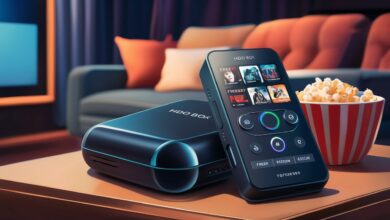Live Event Streaming Mastery: Best Practices for Seamless Success

Live event streaming can be incredibly stressful. You have to worry about technical glitches, audience engagement, and making sure everything runs smoothly.
It can feel overwhelming, especially when you know how important it is to deliver a flawless experience for both virtual and in-person attendees. Whether it’s a corporate event, a concert, or a conference, you want everything to go perfectly.
That’s where event production services come in. These experts have helped countless organisations create successful live events. They know the ins and outs of live streaming and are dedicated to making your event a success.
In this blog, you’ll learn actionable tips and best practices to ensure your live event streaming goes off without a hitch. Get ready to master live event streaming and deliver an unforgettable experience for your audience.
Understanding the Basics of Live Event Streaming
Live event streaming means broadcasting an event over the internet in real time. This allows people to watch the event live from anywhere in the world.
It’s becoming increasingly important in the event industry because it helps reach a wider audience. Whether it’s a concert, a business conference, or a sports game, live streaming lets more people join in without being physically present.
Types of Live Event Streaming
There are several types of live event streaming:
- Webinars: These are online seminars where experts share knowledge on a specific topic. They usually include presentations and Q&A sessions.
- Virtual Conferences: All conferences are held online, with multiple sessions, speakers, and interactive elements.
- Hybrid Events: These combine in-person attendance with a live stream for remote viewers, offering the best of both worlds.
- Live Performances: This includes concerts, theatre shows, or any live performance broadcast online for fans who can’t attend in person.
Benefits of Live Streaming
Live streaming offers many benefits:
- Extend Reach and Engagement: More people can attend your event, no matter where they are. This increases your audience size and engagement.
- Offer Real-Time Interaction and Feedback: Viewers can interact through live chats, polls, and Q&A sessions, making the event more interactive.
- Provide Content for Future Use: Recorded live streams can be used later for marketing, training, or as a resource for those who missed the live event. This extends the value of your event long after it’s over.
Planning and Preparation
Setting Clear Objectives
Before you start planning your live stream, it’s important to know what you want to achieve. Are you aiming to engage with your audience, generate leads, or increase brand awareness?
Defining your goals will assist you in guiding your planning and measure the success of your event.
Choosing the Right Platform
Different platforms offer different features. For example:
- Zoom: Great for interactive meetings and webinars.
- YouTube Live: Ideal for reaching a large audience and keeping the video available after the event.
- CrowdComms: Ideal for virtual and hybrid events. This event app comes with features like customizable apps, interactive live polls, Q&A sessions, and detailed analytics for audience engagement.
- Facebook Live: Good for engaging with followers on social media.
Evaluate each platform’s features and choose the one that best fits your event’s needs.
Assembling the Right Team
A successful live stream requires a skilled team. Key roles include:
- Producers: Oversee the entire production, ensuring everything runs smoothly.
- Technical Crew: Handle the equipment, such as cameras and microphones.
- Moderators: Manage audience interactions, like live chats and Q&A sessions.
Having the right people in these roles will help ensure your event is professional and well-organised.
Rehearsal and Testing
Rehearsals are essential to identify and fix any potential problems before the live event. During rehearsals:
- Test Internet Connections: Ensure your internet is fast and stable to avoid disruptions.
- Check Audio and Video Quality: Make sure the sound is clear and the video is high-quality.
- Run Through the Event: Practise the flow of the event to spot any issues and make necessary adjustments.
Rehearsing will help you feel prepared and confident on the day of the event.
Technical Setup and Equipment
Essential Equipment
To ensure a high-quality live stream, you’ll need the right equipment:
- Cameras: Choose good quality cameras to capture clear and sharp video. Position them strategically to get the best angles of your event.
- Microphones: Use high-quality microphones to ensure your audience can hear everything clearly. This is especially important for speakers and performers.
- Lighting: Proper lighting is crucial to make sure your video looks professional. Good lighting helps to avoid shadows and ensures your subjects are well-lit and visible.
Internet Connection
A secure and fast internet connection is vital for a smooth live stream. Without a reliable connection, your stream might buffer, lag, or even drop entirely, ruining the viewer experience.
Use a wired connection instead of Wi-Fi for more stability. Ensure your upload speed is sufficient for streaming. Close unnecessary applications that might use bandwidth.
Backup Plans
Always have a backup plan in case something goes wrong:
- Backup Internet Connection: Have a secondary internet source, like a mobile hotspot, ready to switch to if your main connection fails.
- Backup Equipment: Keep extra cameras, microphones, and other essential gear on hand in case of technical issues. Being prepared for the unexpected will help keep your livestream running smoothly.
Content Creation and Engagement
Creating Engaging Content
To keep your viewers interested, you need to create high-quality content. Good content captures and holds the audience’s attention, making them want to stay and participate in your event.
Make your content interactive by using polls and live Q&A sessions, and encourage audience participation. This helps keep viewers engaged and makes the experience more enjoyable for them.
Visual and Audio Quality
High-quality visuals and audio are crucial for a successful live stream:
- High-Definition Video: Ensure your video is clear and sharp. High-definition video helps make your event look professional and keeps viewers engaged.
- Clear Audio: Good audio quality is just as important as video. Ensure your audience can hear everything clearly without any distractions or distortions.
Engagement Strategies
Keeping your audience engaged in real-time is key to a successful event:
- Real-Time Interaction: Encourage viewers to interact during the event through live chats, Q&A sessions, and social media. Respond to their comments and questions to make them feel involved.
- Utilising Social Media: Use social media channels to promote your event before, during, and after it takes place. Engage with your audience on social media spaces like Twitter, Facebook, and Instagram to increase participation and create buzz around your event.
Managing Live Events in Real-Time
Monitoring and Moderation
During a live event, it’s essential to have moderators. Moderators are responsible for handling questions and comments from the audience. They ensure that the conversation stays respectful and on-topic. They also help address any issues that arise during the event.
Troubleshooting Technical Issues
Technical problems can happen, so it’s important to be ready to fix them quickly. Be prepared for issues like poor audio quality, video lag, or connection problems.
Have solutions ready, such as adjusting audio levels, restarting the stream, or switching to backup equipment, to resolve these problems swiftly.
Adapting on the Fly
Flexibility is key during live events. Sometimes, unexpected changes occur, like a speaker running late or a sudden technical glitch. Be ready to adapt by having a plan B for various scenarios. This might mean adjusting the schedule, switching to a different segment, or troubleshooting technical problems on the spot. Being adaptable ensures the event continues smoothly despite any hiccups.
Final Words
Understand the basics and set clear objectives to ensure a seamless live event streaming experience. Choose the right platform, assemble a skilled team, and conduct thorough rehearsals.
If you want your live event streaming to be a success, consider reaching out for professional event production services. The team of experts is here to help you every step of the way. Contact them today to learn more and get started.



